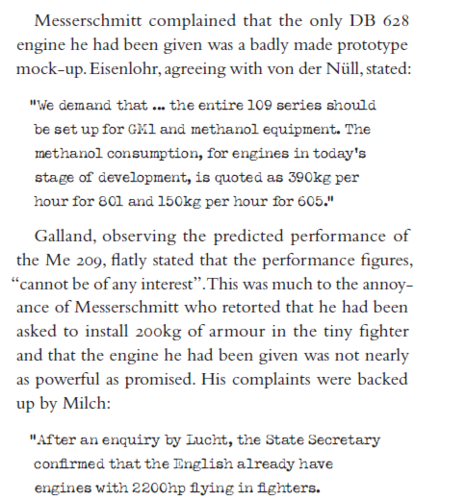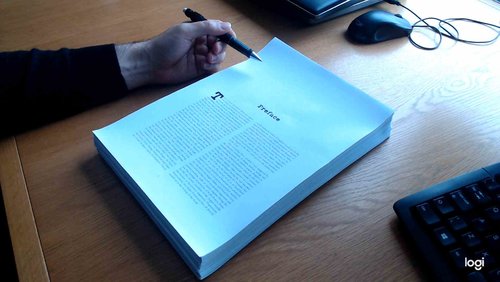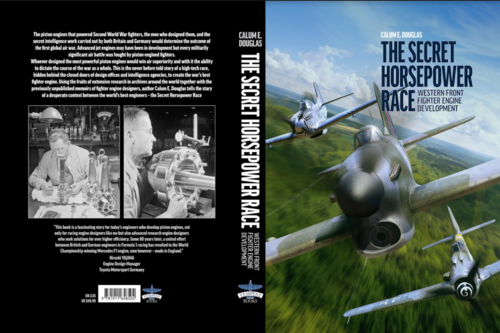You are using an out of date browser. It may not display this or other websites correctly.
You should upgrade or use an alternative browser.
You should upgrade or use an alternative browser.
The Secret Horsepower Race by Calum Douglas (and piston engine discussion)
- Thread starter edwest4
- Start date
- Joined
- 31 May 2006
- Messages
- 657
- Reaction score
- 439
SO looking forward to this, but then I find the low comedy of the Third Reich irresistable.
- Joined
- 31 May 2006
- Messages
- 657
- Reaction score
- 439
Only the Third Reich made mistakes?
No, not what I'm saying.
Only the Third Reich made mistakes?
No, not what I'm saying.
Would you care to clarify?
Best,
Ed
- Joined
- 31 May 2006
- Messages
- 657
- Reaction score
- 439
There is low comedy in many of the technical efforts of all the combatant powers; however, I find the Third Reich particularly amusing because of their bumptious overconfidence and the fact that some still believe that, in technical terms, they were far ahead of everyone else. History can be funny. Even technical history.
There is low comedy in many of the technical efforts of all the combatant powers; however, I find the Third Reich particularly amusing because of their bumptious overconfidence and the fact that some still believe that, in technical terms, they were far ahead of everyone else. History can be funny. Even technical history.
Thank you. My primary focus is technical history with development as the lead.
- Joined
- 25 June 2014
- Messages
- 1,564
- Reaction score
- 1,498

Tragicomedy - Wikipedia
View attachment 640452
Final page-check of the draft, before its sent to the printers. Currently half way through, hopeful printing will commence in 3 weeks.
I do this all the time. Best of luck.
Ed
Sincere congratulation for the book Mr. Douglas,
I would like to ask you whether I can find some technical works or debates on gasoline prechamber engines in your book, which may have inspired through the years the engineers to create and develop the turbulent jet ignition (TJI) system used since 2014 on cars in Formula 1.
Thanks a lot,
Scaz
I would like to ask you whether I can find some technical works or debates on gasoline prechamber engines in your book, which may have inspired through the years the engineers to create and develop the turbulent jet ignition (TJI) system used since 2014 on cars in Formula 1.
Thanks a lot,
Scaz
Sincere congratulation for the book Mr. Douglas,
I would like to ask you whether I can find some technical works or debates on gasoline prechamber engines in your book, which may have inspired through the years the engineers to create and develop the turbulent jet ignition (TJI) system used since 2014 on cars in Formula 1.
Thanks a lot,
Scaz
Yes, the book covers the inception of gasline prechamber turbulent jet ignition. It wasnt done in exactly the same way, but in general terms it is doing the same thing.
Most of the work was done by Dipl-Ing Penzig at IG Farben in 1939/1940.
Thank you very much!!Sincere congratulation for the book Mr. Douglas,
I would like to ask you whether I can find some technical works or debates on gasoline prechamber engines in your book, which may have inspired through the years the engineers to create and develop the turbulent jet ignition (TJI) system used since 2014 on cars in Formula 1.
Thanks a lot,
Scaz
Yes, the book covers the inception of gasline prechamber turbulent jet ignition. It wasnt done in exactly the same way, but in general terms it is doing the same thing.
Most of the work was done by Dipl-Ing Penzig at IG Farben in 1939/1940.
Thank you very much!!Sincere congratulation for the book Mr. Douglas,
I would like to ask you whether I can find some technical works or debates on gasoline prechamber engines in your book, which may have inspired through the years the engineers to create and develop the turbulent jet ignition (TJI) system used since 2014 on cars in Formula 1.
Thanks a lot,
Scaz
Yes, the book covers the inception of gasline prechamber turbulent jet ignition. It wasnt done in exactly the same way, but in general terms it is doing the same thing.
Most of the work was done by Dipl-Ing Penzig at IG Farben in 1939/1940.
Its only covered to a very small degree in the book, as the book is concentrating on operationally significant developments, and the theme would need at least 30 pages to cover properly. However, I think what I cover is enough for you to understand what was done, why and how.
I`m writing a journal paper on the subject with an Italian university at the moment, so the "full" materials on that will come out soon enough.
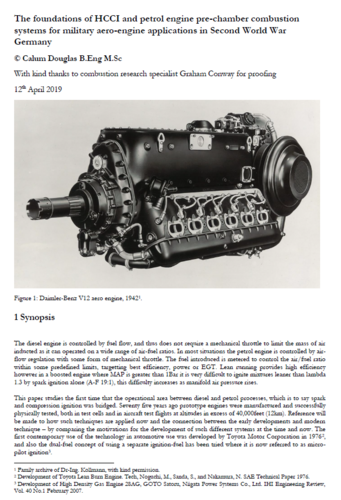
Calum, any evidence of electronic fuel injection on aircraft engines from that period? The Italian Fuscaldo tried it in cars.Thank you very much!!Sincere congratulation for the book Mr. Douglas,
I would like to ask you whether I can find some technical works or debates on gasoline prechamber engines in your book, which may have inspired through the years the engineers to create and develop the turbulent jet ignition (TJI) system used since 2014 on cars in Formula 1.
Thanks a lot,
Scaz
Yes, the book covers the inception of gasline prechamber turbulent jet ignition. It wasnt done in exactly the same way, but in general terms it is doing the same thing.
Most of the work was done by Dipl-Ing Penzig at IG Farben in 1939/1940.
Its only covered to a very small degree in the book, as the book is concentrating on operationally significant developments, and the theme would need at least 30 pages to cover properly. However, I think what I cover is enough for you to understand what was done, why and how.
I`m writing a journal paper on the subject with an Italian university at the moment, so the "full" materials on that will come out soon enough.
View attachment 640608
I do not believe that was technically possible at the time, I`m sure that in some lab somewhere someone could in theory have tried it on a very oversized simple injector on a basic test engine, but I have not uncovered evidence of it. I dont think it would have been concievable to develop it at the time in the way we currently understand such systems (i.e. miniaturised form you could use in a real service engine).
However, the fact I`ve not found it is no proof of non-existence !
Before I found a report on it, I would also probably have told you that developing ceramic valves was impossible too. But they did.....
whats that saying ? "He who believes something is impossible should not disturb those doing it" (or something like that !)
However, the fact I`ve not found it is no proof of non-existence !
Before I found a report on it, I would also probably have told you that developing ceramic valves was impossible too. But they did.....
whats that saying ? "He who believes something is impossible should not disturb those doing it" (or something like that !)
Thanks for the input! Ottavio Fuscaldo developed in the late 30's actually a electromagnetic fuel injection system.I do not believe that was technically possible at the time, I`m sure that in some lab somewhere someone could in theory have tried it on a very oversized simple injector on a basic test engine, but I have not uncovered evidence of it. I dont think it would have been concievable to develop it at the time in the way we currently understand such systems (i.e. miniaturised form you could use in a real service engine).
However, the fact I`ve not found it is no proof of non-existence !
Before I found a report on it, I would also probably have told you that developing ceramic valves was impossible too. But they did.....
whats that saying ? "He who believes something is impossible should not disturb those doing it" (or something like that !)
Thanks for the input! Ottavio Fuscaldo developed in the late 30's actually a electromagnetic fuel injection system.I do not believe that was technically possible at the time, I`m sure that in some lab somewhere someone could in theory have tried it on a very oversized simple injector on a basic test engine, but I have not uncovered evidence of it. I dont think it would have been concievable to develop it at the time in the way we currently understand such systems (i.e. miniaturised form you could use in a real service engine).
However, the fact I`ve not found it is no proof of non-existence !
Before I found a report on it, I would also probably have told you that developing ceramic valves was impossible too. But they did.....
whats that saying ? "He who believes something is impossible should not disturb those doing it" (or something like that !)
I see yes, well it appears a rare occasion when automotive was in advance of aero. I suppose I`ve missed that as my research is almost exclusively aero.
- Joined
- 19 July 2016
- Messages
- 4,245
- Reaction score
- 3,430
Still happy.
- Joined
- 25 July 2007
- Messages
- 4,297
- Reaction score
- 4,180
I see yes, well it appears a rare occasion when automotive was in advance of aero. I suppose I`ve missed that as my research is almost exclusively aero.
FWIW, most of Ottavio Fuscaldo's patents on electromagnetically-controlled fuel injection were filed on behalf of Aeroplani Caproni S.A. Eg:
CH198796A A method of injecting fuel into an internal combustion engine, and device for its implementation, 1937
CH207775A A method of injecting fuel into an internal combustion engine, and device for its implementation, 1938
ES148817A1 Improvements in electromagnetic injectors for internal combustion engines, November 1939
CH240368A Electromagnetically actuated fuel injector for internal combustion engine, applied January 1941
Fuscaldo also designed aero-engines at Caproni - among them a 1929 series of modular radials with 3,5, 7, or 9 cylinders - not sure if any other than the 7-cylinder 'Fuscaldo 90 hp' were built.
I see yes, well it appears a rare occasion when automotive was in advance of aero. I suppose I`ve missed that as my research is almost exclusively aero.
FWIW, most of Ottavio Fuscaldo's patents on electromagnetically-controlled fuel injection were filed on behalf of Aeroplani Caproni S.A. Eg:
CH198796A A method of injecting fuel into an internal combustion engine, and device for its implementation, 1937
CH207775A A method of injecting fuel into an internal combustion engine, and device for its implementation, 1938
ES148817A1 Improvements in electromagnetic injectors for internal combustion engines, November 1939
CH240368A Electromagnetically actuated fuel injector for internal combustion engine, applied January 1941
Fuscaldo also designed aero-engines at Caproni - among them a 1929 series of modular radials with 3,5, 7, or 9 cylinders - not sure if any other than the 7-cylinder 'Fuscaldo 90 hp' were built.
My Italian helper has reported back and said that when he was last at Trento, he looked in the Fuscaldo "folder", and found it was empty ! - Which is probably why I`ve not got the
archives documents to have included such work. However, the patents were unknown to me. So thanks.
We`ll keep searching.
Calum,
I tried the Italian Patent and Trademark Office but a search for the 1937 patent produced no result. I then found some information on Google Patents. It mentions an application filing on January 27, 1939 and what I presume to be a reference to the original Italian patent, given as IT2310773X. The US filing is dated January 26, 1940.
I tried the Italian Patent and Trademark Office but a search for the 1937 patent produced no result. I then found some information on Google Patents. It mentions an application filing on January 27, 1939 and what I presume to be a reference to the original Italian patent, given as IT2310773X. The US filing is dated January 26, 1940.
Last edited by a moderator:
- Joined
- 19 July 2016
- Messages
- 4,245
- Reaction score
- 3,430
Hi Calum,
would it be possible for you to sign the copies of your book already pre-ordered? I've had mine on backorder, since early April, via Booktopia here in Oz.
If possible this would be very nice indeed.
- Joined
- 8 January 2006
- Messages
- 1,607
- Reaction score
- 746
I'll second that, especially since my copy is pre-ordered with Morton's.Hi Calum,
would it be possible for you to sign the copies of your book already pre-ordered? I've had mine on backorder, since early April, via Booktopia here in Oz.
If possible this would be very nice indeed.
- Joined
- 31 May 2006
- Messages
- 657
- Reaction score
- 439
Just to say that Calum signing copies that are being delivered to Morton's might be tricky due to the ongoing apocalypse. If pre-ordered copies were signed that would be great but I will be happy just to get the book!
Just to say that Calum signing copies that are being delivered to Morton's might be tricky due to the ongoing apocalypse. If pre-ordered copies were signed that would be great but I will be happy just to get the book!
Yes I had not expected the great Cthulhu to arise from the deep quite so soon, so we`ll have to see if I can even travel to the publisher to sign some...
Confirming that the final book is now off to printers, we expect postal distribution in 5 weeks. Thanks for waiting.
- Joined
- 19 July 2016
- Messages
- 4,245
- Reaction score
- 3,430
From what we have seen, well worth the wait and dfieintely NOT worth hassling people to go any faster on. Looking forward immensely to this arriving.
I can reveal the Foreword is by James Allison, Technical Director of Mercedes AMG Petronas F1 team, one of the
most respected Technical Directors in motor-sport.
Everyone who ordered direct from the publisher Mortons until now (400) gets a signed copy, and the next
200 will as well (providing its direct from the Mortons website below)
So far we`ve sold 1175 of 2000 copies due to be printed. So I`m well pleased.
 www.mortonsbooks.co.uk
www.mortonsbooks.co.uk
A tiny sneak-peek of the print-ready pdf`s for you all....

most respected Technical Directors in motor-sport.
Everyone who ordered direct from the publisher Mortons until now (400) gets a signed copy, and the next
200 will as well (providing its direct from the Mortons website below)
So far we`ve sold 1175 of 2000 copies due to be printed. So I`m well pleased.
Error | Mortons Books
A tiny sneak-peek of the print-ready pdf`s for you all....
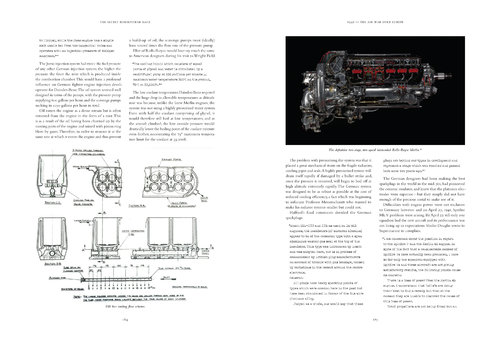
Dagger
ACCESS: Secret
- Joined
- 24 December 2019
- Messages
- 334
- Reaction score
- 620
Calum,
When you talk in your text about gallons I assume you mean imperial gallons?
A lot of readers however, not only Americans, may automatically assume US gallons.
Moreover the text is about a German engine, surely they did not use gallons but liters, so now I wonder: what did the original German document state?
It becomes even more confusing when looking at the quote from Ellor of Rolls Royce talking to American designers and stating "........ water is circulated by a centrifugal pump at 250 gallons per minute .....". Ellor may have meant imperial, but the Americans may have assumed US gallons. Or maybe Ellor meant US gallons as he knew he was talking to Americans, while the Americans assumed imperial gallons, as they knew they were listening to an Englishman.
It is also strange that Ellor uses in the same quote a mix of imperial units and metric units, as he states temperatures in oC.
When you talk in your text about gallons I assume you mean imperial gallons?
A lot of readers however, not only Americans, may automatically assume US gallons.
Moreover the text is about a German engine, surely they did not use gallons but liters, so now I wonder: what did the original German document state?
It becomes even more confusing when looking at the quote from Ellor of Rolls Royce talking to American designers and stating "........ water is circulated by a centrifugal pump at 250 gallons per minute .....". Ellor may have meant imperial, but the Americans may have assumed US gallons. Or maybe Ellor meant US gallons as he knew he was talking to Americans, while the Americans assumed imperial gallons, as they knew they were listening to an Englishman.
It is also strange that Ellor uses in the same quote a mix of imperial units and metric units, as he states temperatures in oC.
Last edited:
Calum,
When you talk in your text about gallons I assume you mean imperial gallons?
A lot of readers however, not only Americans, may automatically assume US gallons.
Moreover the text is about a German engine, surely they did not use gallons but liters, so now I wonder: what did the original German document state?
It becomes even more confusing when looking at the quote from Ellor of Rolls Royce talking to American designers and stating "........ water is circulated by a centrifugal pump at 250 gallons per minute .....". Ellor may have meant imperial, but the Americans may have assumed US gallons. Or maybe Ellor meant US gallons as he knew he was talking to Americans, while the Americans assumed imperial gallons, as they knew they were listening to an Englishman.
It is also strange that Ellor uses in the same quote a mix of imperial units and metric units, as he states temperatures in oC.
The numbers are from a British study OF said German engine and hence is in gallons and is from a British paper, which anyone reading it would know which implies natually its not US gallons -
however you wont know that from looking at a two page preview. So I`d urge you to buy the book and read it in full for clarity.
The quotes often contain strange combinations of units, because (as here) you have an American writing a report for Americans, using information given to him by a British engineer vising America.
Thats one of the issues with direct quotes, sometimes people write in an unexpected style, and so as a writer you either have to fill the entire book with clarifications after each quote, or
not use quotes, or just try to make sure there is enough context in each case for the reader to grasp whats happening. I`ve chosen #3. Thats not Ellor speaking, its what an American engineer
recorded of his meeting. One may sometimes need to look up one of the extremely numerous end-notes to clarify things like that here and there.
If lots of people find it spoils the book, we`ll add in exact clarifications in future editions, however I feel with the context you`ll get from reading the actual book, in the vast majority of cases it will be
pretty clear. Its a narrative, so doesnt lend itself to "dipping into", as you wont know where what your reading relates to.
Very significant efforts have been made to accomodate US readers, such as changing the date for every single date (outside quotes) to "Aug 28" format, instead of 28/08 ... etc, so a
great deal of work has been put in to minimise cross-cultural confusion.
Feedback on any text-errors and general suggestions for improvement is most gratefully recieved, but I would very strongly suggest refraining from doing so until you have the actual book in-hand,
for the reasons given above.
Last edited:
Dagger
ACCESS: Secret
- Joined
- 24 December 2019
- Messages
- 334
- Reaction score
- 620
Some may find this nitpicking but as a chemical engineer working at an American design company (retired now) I have seen through the years many mistakes being made with gallons as most of my coworkers, especially the younger ones, automatically assume that a gallon is 3.785 liters, even if it is mentioned in a clearly British document. I therefor have always urged coworkers to be careful when reading a document, and be clear which gallons one means when writing about them.
The same problem occurs in my profession with pressure units. Some people automatically assume that psi (or kg/cm2, or bar, or kpa, or Mpa, or ....) means absolute pressure, while others automatically assume it is gauge pressure. I have always insisted on my projects that everybody state either psig or psia, not psi, also clients. Assumption is the mother of all f#ck-ups.
In the top left corner of the two page preview there is a quote in which psi is mentioned. The numbers are big so in this particular case it does not really matter whether psig or psia is meant.
However there may be pressure data in the text of your book where psi (or kg/cm2, or bar, or kpa, or Mpa, or ....) are mentioned and where the number is small enough that it does make a difference whether psig or psia is meant.
Maybe you can think about that and let us know how to interpret pressure data without an a or g in your text before we start reading your undoubtedly interesting book.
The same problem occurs in my profession with pressure units. Some people automatically assume that psi (or kg/cm2, or bar, or kpa, or Mpa, or ....) means absolute pressure, while others automatically assume it is gauge pressure. I have always insisted on my projects that everybody state either psig or psia, not psi, also clients. Assumption is the mother of all f#ck-ups.
In the top left corner of the two page preview there is a quote in which psi is mentioned. The numbers are big so in this particular case it does not really matter whether psig or psia is meant.
However there may be pressure data in the text of your book where psi (or kg/cm2, or bar, or kpa, or Mpa, or ....) are mentioned and where the number is small enough that it does make a difference whether psig or psia is meant.
Maybe you can think about that and let us know how to interpret pressure data without an a or g in your text before we start reading your undoubtedly interesting book.
So much easier if everyone used metric units...
Maybe you can think about that and let us know how to interpret pressure data without an a or g in your text before we start reading your undoubtedly interesting book.
It is not recorded in the original report, the main reason for that, ought to be
very obvious.... as you well know atmospheric pressure is 14.7 PSI, and, as you well know when discussing pressures of 1100 or 4500 PSI
the distinction between Gauge and Atmosphere as the ref point, has absolutely no meaning whatsoever because the difference is likely to be far smaller than the meaningful resolution of the measurement
devices of the era, and such it has no practical influence to the point. Sadly the persons who wrote these report are all very dead, so I have to decide
what is sufficiently unclear to warrant omission, and what isn't.
My approach is that if the reader may be fooled into spuriously thinking the Jumo max fuel pressure was 4485.3 and not 4514.7 PSI "A" - I consider that
a realively minor price relative to "we dont know what the presure was". The rounding undoubtedly used by Frank Halford the author, also make it
even more meaningless to consider such trivialities. It is likely from the results that he rounded at at least the nearest 10PSI and in fact quite probable
in my view that +/-100PSI was a realistic error for such figures.
Where the distinction between gauge and absolute is relevant & available from the original documents (i.e. boost pressure) naturally the reader is provided with this data as in that
eventuality the difference may represent an error of up to three times entire value.
Last edited:
Hi Calum,
thanks for letting us know that you'll be signing only those books sent, via Mortons, direct to us. Being the one that suggested that it would be great if you could sign your pre-ordered copies, I'd be peeved if I didn't do what you asked of us. I'm really looking forward to receiving your tome!
thanks for letting us know that you'll be signing only those books sent, via Mortons, direct to us. Being the one that suggested that it would be great if you could sign your pre-ordered copies, I'd be peeved if I didn't do what you asked of us. I'm really looking forward to receiving your tome!
Similar threads
-
Messerschmitt Me 309 Development & Politics by Dan Sharp and Calum E. Douglas
- Started by newsdeskdan
- Replies: 285
-
Secret Projects of the Luftwaffe by Dan Sharp
- Started by newsdeskdan
- Replies: 49
-
Killer Rays: Story of the Douglas F4D Skyray & F5D Skylancer
- Started by overscan (PaulMM)
- Replies: 14
-
Eyes in the Sky: Eisenhower, the CIA and Cold War Aerial Espionage
- Started by overscan (PaulMM)
- Replies: 0

